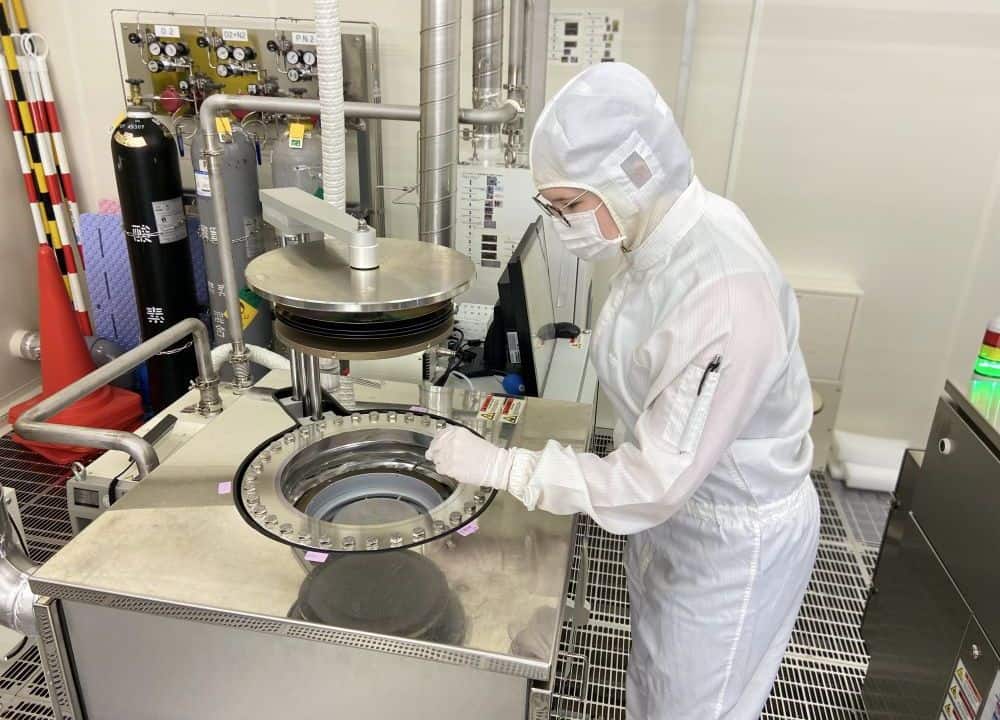
[Image above] Penn State Ph.D. candidate Katelyn Kirchner working on 2D glasses during her recent stay in Hokkaido University, Japan, where she worked with professor Madoka Ono. Kirchner was lead author of a recent review paper on how spatial and temporal structural deviations affect glass-forming oxide systems. Credit: Katelyn Kirchner
As discussed on CTT last Tuesday, many fundamental glass processes remain a “black box” to materials scientists despite the ubiquity of glass in our lives.
This uncertainty is due largely to the complexity of the glass atomic structure. Unlike metals and ceramics, which consist of highly ordered, long-range structures, glasses consist of disordered, short- and medium-range structures that are not thermodynamically stable. Because of this instability, glass slowly but steadily evolves over time toward a metastable supercooled liquid state.
These deviations of the glass atomic structure in space and time are referred to as spatial and temporal fluctuations, respectively. Fluctuations can significantly affect the macroscopic properties of a glass, yet most studies to date do not account for these deviations.
A lack of theoretical and experimental tools to quantify and assess the impacts of fluctuations is partially why fluctuations are traditionally not considered. But it is also due to the tendency to view materials as having particular property values rather than acknowledging that, in most cases, these values are averages containing fluctuations.
Fortunately, fluctuations are gaining more attention in the theoretical statistical physics community. Critical works, such as here and here, have helped advance understanding of the fundamental physical nature of model glassy systems by considering the effect of fluctuations.
“However, a comprehensive review of the physical chemistry of spatial and temporal fluctuations of structural glass materials (e.g., oxide, metallic, and chalcogenide glasses) is currently missing,” researchers write in a recent paper.
The researchers are led by ACerS Fellow John Mauro, Dorothy Pate Enright Professor and associate head for graduate education at The Pennsylvania State University, and Penn State Ph.D. candidate Katelyn Kirchner. The group includes numerous students and professors from Penn State, plus colleagues from Federal University of São Carlos in Brazil, Hokkaido University in Japan, Aalborg University in Denmark, and the University of California, Los Angeles.
To help fill this gap, their new paper comprehensively reviews various experimental and computational techniques used to characterize and evaluate the effects of spatial and temporal fluctuations on commercially relevant glass systems, primarily oxide glasses. Some highlights from the 67-page review are below.
The kinetic and thermodynamic origins of glass fluctuations
After providing a precise and mathematical description for the term “fluctuations,” the researchers then explain the community’s current understanding for the thermodynamic and kinetic origins of fluctuations in glass-forming systems. Specifically,
- Thermodynamics is the driving force for the transition from the nonequilibrium (thermodynamically unstable) glassy state to the equilibrium (metastable) supercooled liquid state. Properties such as heat capacity, thermal expansion coefficient, and compressibility can be calculated from quantified fluctuations in thermodynamic parameters.
- Kinetics sets the rate and intermediate steps required for the transition to occur. Kinetically driven properties of specific interest for glass-forming systems, and where temporal fluctuations are most critical, include glass relaxation, crystallization, and phase separation.
Computer simulations based on molecular dynamics, Monte Carlo, and statistical mechanics are a common way to model kinetic and thermodynamic properties.
Techniques for characterizing fluctuations
Numerous spectroscopic and diffraction techniques that are used to characterize short- and medium-range order structural units in glasses can also provide insights on various features of spatial and temporal fluctuations. For example,
- Nuclear magnetic resonance allows for Qn speciation,
- Diffraction or vibrational spectroscopy techniques can reveal bonding fluctuations,
- Raman spectra can lead to ring size determination, and
- Small-angle scattering can measure density fluctuations.
While experimental techniques can provide indirect signatures of the structure of glasses with high precision, they come at the high cost of time and equipment. So, these techniques are often paired with computational approaches, such as the molecular dynamics and statistical mechanics simulations mentioned in the section above.
Computer modeling allows hypotheses to be tested in a time- and cost-effective manner before the most promising conjectures are confirmed with experiments.
However, there are challenges with developing computational techniques for studying spatiotemporal fluctuations in glass-forming systems, including the applicability of models over relevant time and length scales and the ability to discern physically meaningful fluctuations from calculation noise.
The role of spatiotemporal fluctuations in structure–property–performance relationships
The second half of the paper, sections 6−10, is dedicated to describing the role of spatiotemporal fluctuations in several important structure–property–performance relationships, including glass relaxation, crystallization, and phase separation; effects on mechanical and optical properties are also discussed.
Ultimately, the researchers conclude that “When tailoring a glass design with unusual properties or specific applications in mind, the overarching question is how fluctuations can be leveraged as an additional parameter to the composition and thermal/pressure history.”
“By explicitly considering the magnitude of fluctuations with this list of parameters, glass applications with stringent requirements on mechanical and optical properties can be more finely tuned, especially in relation to newly developing large-scale manufacturing techniques, such as additive manufacturing,” they write.
The paper, published in Chemical Reviews, is “Beyond the average: Spatial and temporal fluctuations in oxide glass-forming systems” (DOI: 10.1021/acs.chemrev.1c00974).
Author
Lisa McDonald
CTT Categories
- Basic Science
- Education
- Glass


